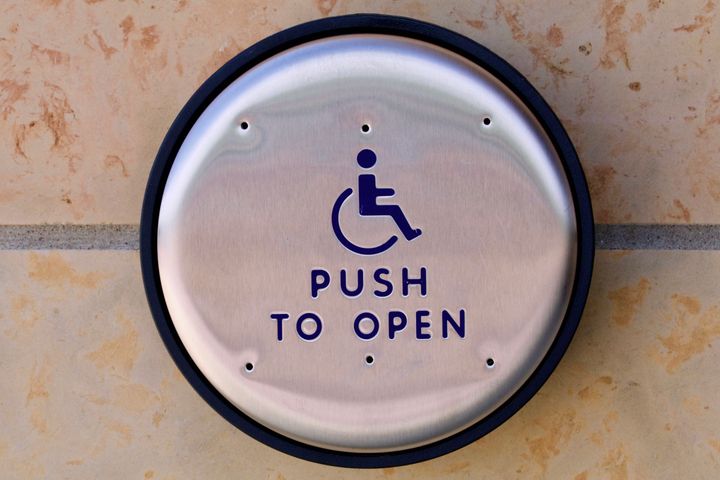
What do you think of when you hear the phrase “confined to a wheelchair”? Do you feel pity? Do you focus on a loss of mobility? To me, the words conjure an image of fragility and weakness. They create a sense of being trapped ― of being held back. Confined: the word itself means restricted, limited, cramped and inadequate.
“Wheelchair bound” is not much better. It has all the same connotations as “confined to a wheelchair,” while also managing to sound like a very specific BDSM preference. Being bound to a wheelchair sounds simultaneously horrific and titillating.
Neither of these phrases portrays the accurate experience of a wheelchair user, despite their common usage. The truth is, mobility devices are neither confining nor binding. They are freeing.
I’ve always been active. You wouldn’t know it to look at me, with my fat body, coffee in hand, but I am always on the move. At least, I was always on the move.
A lack of a driver’s license, two small children and a propensity for cabin fever used to necessitate frequent walks. A typical day for me involved dropping my oldest son at school and then wandering the city with my youngest in his stroller, collecting fresh air and caffeine along the way, until it was time to claim my oldest at the end of the school day. I was practically nomadic.
Then, at the young age of 36, hours of casual strolling wherever my whims might take me morphed quickly into struggling to walk to the washroom. I couldn’t stand for a full shower, or cook dinner without a chair. Taking my children to the park was an impossibility. I missed their extracurricular classes, and their school open houses. This nomad became immobile.
For two years, I was essentially housebound. Tests showed four spinal conditions, one per vertebrae in my lower back. This indicated the intense pain was not in my head nor due to my weight, which alleviated fears that I had brought this on myself but offered little hope for relief. Orthopedic surgeons refused to see me, citing each condition as being minor but not easily treatable.
I began to retreat as I grappled with my new reality. I could not walk or stand for more than minutes at a time, and it would never get better. I stayed in bed most of the day, reserving my small bit of walking for moving to and from the chair in the living room.
I felt limited. Confined. Bound.
My worldview would be shifted once more with a trip to the hospital for an MRI. The test itself would prove unhelpful, but the trip changed everything.
Murphy’s law being adhered to faithfully in our family, we parked on the opposite end of the building from the imaging department. I took a deep breath, put on a stiff upper lip, and prepared to inch my way through the sprawling hallways, holding on to whatever my hand could reach for.
Ten feet through the door, my husband turned to me, exasperated. “This is ridiculous, just get in and I’ll push you,” he said, gesturing toward the wheelchair docking station.
“No, I’ll walk.” Wheelchairs were for handicapped people. I wasn’t handicapped ― I just couldn’t walk. I would leave those wheelchairs for those frail, weak people who needed them.
Twenty steps further, my pride was felled by my pain, and I collapsed into a wheelchair. Fine. I would allow myself to use this chair in a hospital. I wasn’t bound to it, after all.
The ride to the MRI felt like I was cruising down Route 66 in a ’58 Corvette with the top down. The wind in my hair, the scenery flying by ― it was the fastest I had moved indoors in two years, and the first time I had done so pain-free. I resisted the urge to throw my hands in the air and “Woo!”
I decided in that moment I would never be confined again. My disability was what confined me. The wheelchair had freed me.
I put in a request for a walker, and within weeks, an occupational therapist arrived at my door with a wheeled walker fit with forearm grips. I took it for a spin around the living room, walking relatively pain-free, reminiscent of my days pushing a stroller to the city limits and back.
We celebrated my newfound mobility by taking the kids to the park.
That night, I looked at the step counter I always kept open on my phone. It read: Yesterday, 346 steps. Today, 3,313.
In my best “Braveheart” voice, “Freedom!” rang from my lips.
It’s time to change the script we use surrounding mobility devices. The attitude I formed toward wheelchairs and walkers based on my perception of them when I was able-bodied held me back for two full years. Having been conditioned to see mobility devices as a last resort ― something you used when you no longer had a choice ― I robbed myself of years that I could have been out living life to the fullest.
Forced to face my previous prejudice, I reflected on why my view of walkers and wheelchairs had been so skewed. A lot of it is the language we use.
People with mobility challenges use mobility aids; they aren’t confined or bound by them. They are tools, not traps. We are no more held back by them than is someone using a plane or boat to cross an ocean. They are all simply means we use to get places we wouldn’t be able to navigate without them.
I regret not acknowledging my need for help earlier. I wish I had not equated a walker with defeat or shame. I now talk about walkers, wheelchairs and other disability aids with anyone who will listen in hopes of destigmatizing them and the people who use them. Freedom, not confinement. Tools, not traps. I will keep repeating this until everyone who needs to break free feels comfortable using them.
Do you have a personal story you’d like to see published on HuffPost? Find out what we’re looking for here and send us a pitch!
